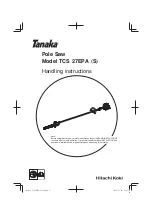
32
EngLIsh
Chargers
D
e
WALT
chargers require no adjustment and are designed to be
as easy as possible to operate.
Electrical Safety
The electric motor has been designed for one voltage only.
Always check that the battery pack voltage corresponds to the
voltage on the rating plate. Also make sure that the voltage of
your charger corresponds to that of your mains.
i
Your
D
e
WALT
charger is double insulated in accordance
with EN60335; therefore no earth wire is required.
If the supply cord is damaged, it must be replaced only by
D
e
WALT
or an authorised service organisation.
Mains Plug Replacement
(U.K. & Ireland Only)
If a new mains plug needs to be fitted:
• Safely dispose of the old plug.
• Connect the brown lead to the live terminal in the plug.
• Connect the blue lead to the neutral terminal.
WARNING:
No connection is to be made to the
earth terminal.
Follow the fitting instructions supplied with good quality plugs.
Recommended fuse: 3 A.
Residual Risks
In spite of the application of the relevant safety regulations
and the implementation of safety devices, certain residual risks
cannot be avoided. These are:
• Impairment of hearing.
• Risk of personal injury due to flying particles.
• Risk of burns due to accessories becoming hot
during operation.
• Risk of personal injury due to prolonged use.
• Health hazards caused by breathing dust developed when
working in concrete and/or masonry.
•
Direct sparks away from operator, bystanders or
flammable materials.
Sparks may be produced while using
a sander or grinder. Sparks may cause burns or start fires.
•
Always use front handle. Tighten the handle securely.
The front handle should always be used to maintain control of
the tool at all times.
•
Never cut into area that may contain electrical wiring or
piping.
Serious injury may result.
•
Clean out your tool often, especially after heavy use.
Dust and grit containing metal particles often accumulate on
interior surfaces and could create an electric shock hazard.
•
Do not operate this tool for long periods of time.
Vibration caused by tool action may be harmful to your
hands and arms.
Use gloves to provide extra cushion and
limit exposure by taking frequent rest periods.
•
Dust, crystalline material, vapor and smoke may be
produced while working.
Always wear a dust mask or
respiratory protection. Danger for health!
Additional Safety Information
•
Do not use the upper quarter of the wheel for cutting
.
Serious injury may result due to kickback.
•
Use of accessories not specified in this manual is not
recommended and may be hazardous.
Use of power
boosters that would cause the tool to be driven at speeds
greater than its rated speed constitutes misuse.
•
Do not use circular saw blades with this tool.
Serious
injury may result.
•
Avoid bouncing the wheel or giving it rough treatment.
If this occurs, stop the tool and inspect the wheel for cracks
or flaws.
b )
Never place your hand near the rotating accessory.
Accessory may kickback over your hand.
c )
Do not position your body in line with the rotating
wheel.
Kickback will propel the tool in direction opposite
to the wheel’s movement at the point of snagging.
d )
Use special care when working corners, sharp edges
etc. Avoid bouncing and snagging the accessory.
Corners, sharp edges or bouncing have a tendency to
snag the rotating accessory and cause loss of control
or kickback.
e )
Do not attach a saw chain, woodcarving blade,
segmented diamond wheel with a peripheral gap
greater than 10 mm or toothed saw blade.
Such
blades create frequent kickback and loss of control.
f )
Do not "jam" the wheel or apply excessive pressure.
Do not attempt to make an excessive depth of
cut.
Overstressing the wheel increases the loading and
susceptibility to twisting or binding of the wheel in the cut
and the possibility of kickback or wheel breakage.
g )
When wheel is binding or when interrupting a cut
for any reason, switch off the power tool and hold
the power tool motionless until the wheel comes to
a complete stop. Never attempt to remove the wheel
from the cut while the wheel is in motion otherwise
kickback may occur.
Investigate and take corrective
action to eliminate the cause of wheel binding.
h )
Do not restart the cutting operation in the
workpiece. Let the wheel reach full speed and
carefully re‑enter the cut.
The wheel may bind, walk up
or kickback if the power tool is restarted in the workpiece.
i )
Support panels or any oversized workpiece to
minimize the risk of wheel pinching and kickback.
Large workpieces tend to sag under their own
weight.
Supports must be placed under the workpiece
near the line of cut and near the edge of the workpiece on
both sides of the wheel.
j )
Use extra caution when making a “pocket cut” into
existing walls or other blind areas.
The protruding
wheel may cut gas or water pipes, electrical wiring or
objects that can cause kickback.
Содержание XR DCS691
Страница 1: ...DCS691 ...
Страница 3: ...1 Fig A Fig B 24 16 23 2 1 7 8 13 6 3 10 4 15 11 9 5 14 XXXX XX XX 12 4 24 16 ...
Страница 4: ...2 Fig E Fig F Fig C Fig D Fig G Fig H 8 22 13 13 7 1 17 18 19 20 21 11 ...
Страница 165: ......
Страница 166: ......
Страница 167: ......
















































